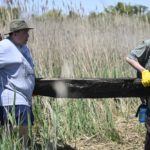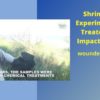 With all the work that Wounded Nature-Working Veterans does to clean up old, treated wood, should you use it? Unfortunately, you are left with that choice, but these facts might help you to understand the issues a little bit better.
With all the work that Wounded Nature-Working Veterans does to clean up old, treated wood, should you use it? Unfortunately, you are left with that choice, but these facts might help you to understand the issues a little bit better.
Pressure-treated wood is as much as 40% cheaper and lasts twice as long as natural redwood. However, the rest of the story goes on a sharp decline.
The most common type of treated wood is designated PT CCA (Pressure Treated Chromated Copper Arsenate). Many governments around the world have called for a phase-out of PT CCA. This is largely due to concerns related to its disposal.
Pressure-treated wood is designed to resist insects, fungi, and bacteria. But it is poisonous to humans and other life forms. It is listed by the State of California (and most other states) as a carcinogen.
The elements involved in this treatment are copper, chromium, and arsenic. All are hazardous to the environment and the health of people and wildlife. And, as if that wasn’t bad enough, these chemicals do not break down into harmless substances as they decay.
The companies that produce CCAs claim that the compounds are chemically locked to the wood itself and therefore not a hazard to the health of humans or the environment. However, these compounds, and particularly the arsenic, are released in highly toxic levels when the wood is burned. So, if a structure built out of these materials accidentally catches fire, these toxins are released in severely toxic levels into the air and water surrounding them.
There is also evidence of arsenic leaching from CCA-treated wood into the surrounding environment. A good example of this is shown in our YouTube video, Shrimp Tank Experiment: How Treated Wood Impacts Wildlife.
example of this is shown in our YouTube video, Shrimp Tank Experiment: How Treated Wood Impacts Wildlife.
Experiments conducted by research groups on this type of treated wood found that the amount of arsenic leached into raised garden beds was limited to an area approximately six inches in diameter, but that six inches is permanently contaminated, and it will stay contaminated long after you and your garden are gone.
This leaching also means that arsenic salts are continually coming to the surface of the wood where they can easily be transferred to humans or wildlife, simply by contact. And these results showed that the contact needed to contaminate someone or something was minimal.
The makers of these products insist that only small amounts of these compounds are found in contaminated soil or water and are generally considered too small to be immediately toxic. However, the effects of repeated exposure to low levels of these chemicals are not well understood.
Disposal of treated wood is a far more serious environmental problem. It should only be placed in lined landfills, but even these aren’t the best solutions. The problem that authorities have noticed is that construction waste is often too bulky and not allowed in these special landfills. The result is that it often ends up in unlined landfills where it is subject to eventual leakage into soil and groundwater.
There are alternatives for treating wood like Alkaline Copper Quaternary. It is manufactured by Chemical Specialties, Inc. (CSI) and, while not entirely benign, it does replace the more seriously toxic chromium and arsenic in the CCA-treated products. Several European countries and Japan, are using it as their only allowable method of treating wood and have banned CCA-treated wood altogether.
Naturally resistant woods such as redwood and cedar are the best choices, but their availability and harvest have radically different environmental impacts. In the western United States, redwood is readily available. The downside is that much of it comes from clear-cut, old-growth forests and the resources are becoming depleted. The loss of these habitats and the watershed in general are causing their environmental damage. Some of this supply comes from managed plantations, but the environmental impacts of tree plantations can be seen in the use of pesticides and other harmful effects on the environment.
Wounded Nature-Working Veterans is working daily to ensure that our critical coastal areas are cleaned and that chemical contaminants are disposed of in an environmentally safe way. If you would like to know how you can help to make a real environmental difference, visit our Volunteer page or Support our mission by donating.
